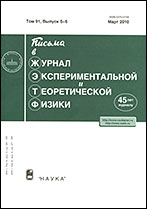|
Эта публикация цитируется в 5 научных статьях (всего в 5 статьях)
КОНДЕНСИРОВАННОЕ СОСТОЯНИЕ
Quantum auto-ionization of molecular excitons and photovoltaic
conversion
V. A. Benderskiia, E. I. Katsbc
a Institute of Problems of Chemical Physics, Russian Academy of Sciences, Chernogolovka, Moscow region
b Landau Institute for Theoretical Physics, Russian Academy of Sciences
c Moscow Institute of Physics and Technology (State University), Dolgoprudny, Moscow region
Аннотация:
This paper explores a novel way of charge separation (auto-ionization) of
molecular excitons, by quantum tunneling through nano-size $p{-}n$ junction.
This mechanism can dominate the standard one (i.e., when Frenkel exciton is
ionized at donor or acceptor impurity sites)
for very short, nano-size, $p{-}n$ junction, where the junction electric field can
be strong for relatively small (on the order of $1$ V) voltage drop.
Within a simple one-dimensional model for the depletion region of the $p{-}n$
junction (donor and acceptor reservoirs connected by a short molecular wire)
we compute the quantum yield $Y_b$ for the tunneling exciton auto-ionization in
the “bulk” of the depletion region.
For modern organic photo-sensitive materials with $p{-}n$ junction size on the
order of $10$–$20$ nm, $Y_b$ could be close to $1$.
Such a high efficiency of the charge separation (one of the main factor entering
figure of merit, indicating how good are photovoltaic conversion
cells) makes this new mechanism potentially very perspective for the
applications.
Поступила в редакцию: 14.11.2014
Образец цитирования:
V. A. Benderskii, E. I. Kats, “Quantum auto-ionization of molecular excitons and photovoltaic
conversion”, Письма в ЖЭТФ, 101:1 (2015), 19–23; JETP Letters, 101:1 (2015), 17–21
Образцы ссылок на эту страницу:
https://www.mathnet.ru/rus/jetpl4512 https://www.mathnet.ru/rus/jetpl/v101/i1/p19
|


| Статистика просмотров: |
| Страница аннотации: | 171 | | PDF полного текста: | 27 | | Список литературы: | 48 | | Первая страница: | 11 |
|





 Обратная связь:
Обратная связь: Пользовательское соглашение
Пользовательское соглашение
 Регистрация посетителей портала
Регистрация посетителей портала Логотипы
Логотипы








 Цитирование в формате
Цитирование в формате 
